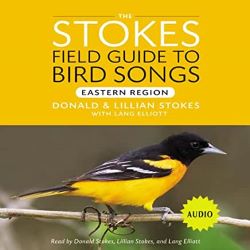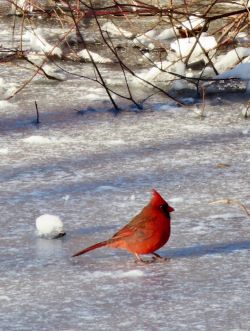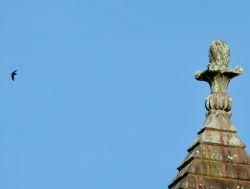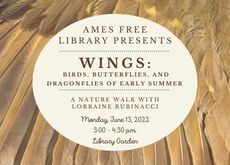Bird song is among the most conspicuous natural phenomena of May. If you have recently walked at the Ames Free Library or, for that matter, anywhere in southeastern Massachusetts, you couldn’t help but hear the chorus: resident birds, newly-arrived migrants, and passers-through are all singing. Those who stay sing to attract mates and to announce their territory. In most, though not all species, the males deliver the songs. They sing like there’s no tomorrow and, indeed, there really isn’t. Our short-lived songbirds must start the process of raising young while food is available.
Like most places, the Ames Free Library has its conspicuous inhabitants: the flashiest, the loudest, and the most numerous. These birds will be the focus of “Wings: Birds, Butterflies, and Dragonflies of Early Summer,” our next seasonal nature walk on Monday, June 13. During this 90-minute walk around the library’s property, we will focus on the behavior of these birds as well as the insects who visit Queset Garden for nectar . . . or prey. This will be a group effort to notice and share the heightened activity of the season. I will offer guidance and practice.
“Wings” is suitable for adults and kids aged 10 and older. Dress comfortably and be prepared for walking on some uneven ground.
We will meet at the library entrance at 2:30. Free and open to all. Binoculars recommended; curiosity essential!
To get you started in the right direction, this post includes a mini challenge: Listen to the three short sound clips below, then choose the matching bird. This is an honor system; no one will know your guess but you, but give it a fair try. The answers will be at the end of the post.
A Bird with a Loud Voice
A) northern flicker
B) northern cardinal
C) blue jay
D) red-tailed hawk
Two Different Species Vocalizing Simultaneously
A) gray catbird & American robin
B) song sparrow & eastern bluebird
C) Carolina wren & American robin
D) eastern bluebird & mourning dove
Several Individuals of Same Species
A) Balitmore orioles
B) European starlings
C) gray catbirds
D) chimney swifts
My advice for the coming week: Whatever your experience level, up the ante. If you have never listened carefully to bird song, perk up your ears. If you already notice bird songs, start matching the sounds with the bird’s appearance. If you can identify some bird species from their songs, start paying more attention to their call notes and the circumstances when the bird will make each kind of sound. Trust me, there’s always more to learn and to enjoy! At the LibraryBirding By Ear: Eastern/Central
by Richard Walton
Stokes Field Guide to Bird Songs
Lang Elliot, Donald Stokes, Lillian
Stokes
Available through Commonwealth Catalog

 Answer Key:
Answer Key:
 #1 Northern cardinal
#1 Northern cardinal
 #2A gray catbird
#2A gray catbird
 #2B American robin
#2B American robin
 #3 chimney swifts
#3 chimney swifts